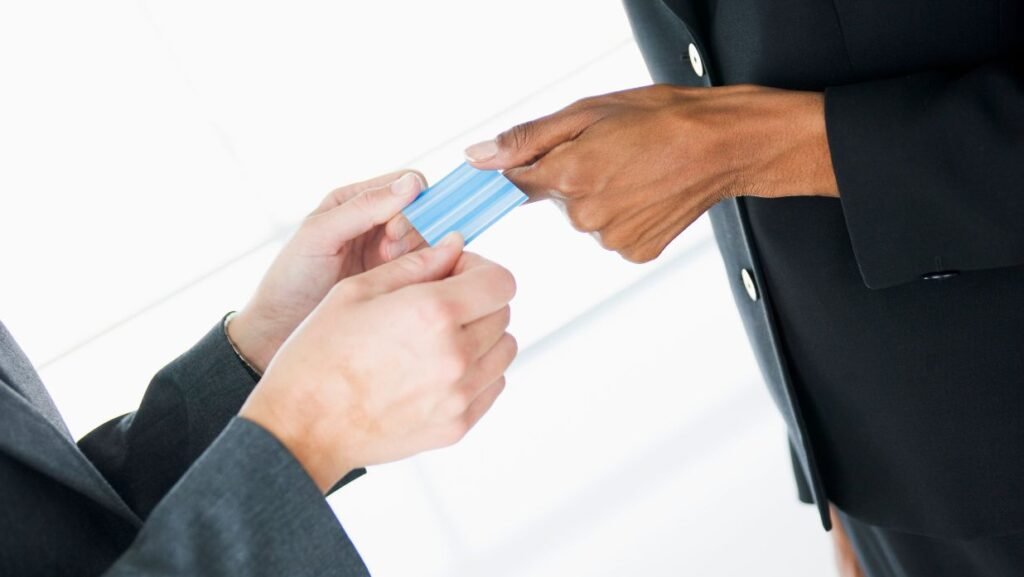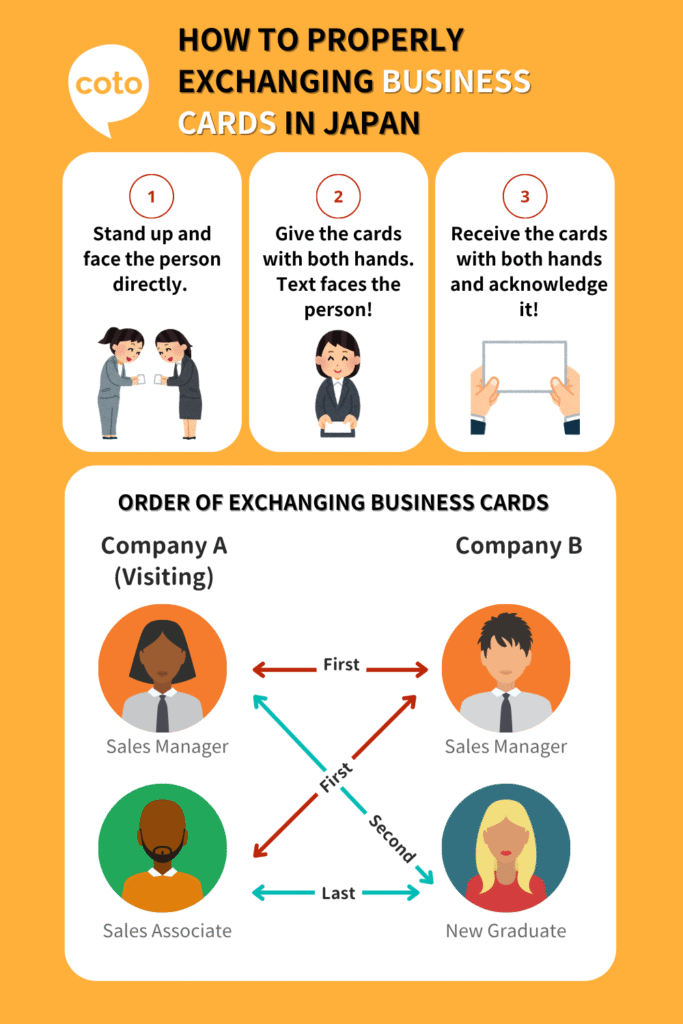When meeting a new client in Japan, one of the first things you need to do is exchange business cards, known as 名刺 (meishi). In many other countries, business cards are often seen as a formality, or even a fading tradition — just a way to pass along your name, title, and company info. But in Japan, meishi exchange is much more than that. It’s a ceremonial act — a ritual that reflects mutual respect, humility, and a commitment to professionalism.
Because meishi play such an important role in Japanese business culture, the act of exchanging them is surrounded by clear etiquette, expectations, and unspoken rules. So, what exactly makes Japanese business cards so important? Do you really need to carry them when working in Japan? And what’s the proper way to exchange them?
In this article, we’ll walk you through essential meishi etiquette, along with what to avoid, so you can make the right impression from your very first meeting.
Want to build a career in Japan? Coto Academy’s 3-month Business Japanese Course is designed to help you master keigo (business Japanese) and improve workplace communication skills. Gain the confidence to speak professionally with colleagues and clients, navigate meetings, and open up new career opportunities!
Importance of a Japanese Business Card

By now, you might have noticed the act of exchanging Japanese business cards is far more ritualistic than in most Western cultures. The card doesn’t just represent its owner, but the whole company. Handing over your meishi the wrong way can damage your professional relationships, or, worse, sully your company’s reputation.
Still, did you know that meishi (名刺) is actually a relatively modern concept? According to one story, business cards didn’t truly exist in Japan until the Meiji period (1868–1912). This era marked the end of Japan’s military government and the restoration of imperial rule. The idea of business cards is believed to have been introduced from Western countries during this time and later adopted by Japanese society.
Another narrative suggests that business cards may have entered Japan even earlier. In 1853, during the late Edo period, American black ships arrived in Tokyo Bay. The U.S. representatives on board used printed cards to identify themselves, possibly marking the first time the Japanese encountered Western-style business cards.
One thing is certain: the tradition of using business cards in Japan was originally adopted from Western business culture
It’s also important to understand that meishi fits naturally into Japanese social norms. In cultures where people greet with hugs, kisses, or handshakes, a business card might seem secondary. But in Japan, where physical contact is more restrained, exchanging business cards becomes a vital and respectful way to initiate a professional connection.
What’s in a Japanese Business Card?
At its core, a business card, regardless of culture, serves one essential purpose: to share contact information. While its symbolic meaning may differ from country to country, the meishi (Japanese business card) still fulfills this same practical role.
Here are the key elements typically included on a Japanese business card:
- Company Name or Logo (Top Placement): The name or logo of the organization is usually placed at the top of the card and is often the most prominent element.
- Your Full Name (Family Name First): Unlike in many Western cultures, the family name is listed before the given name. Furigana (phonetic guides) are often included to indicate pronunciation. If you have a Western name, it’s acceptable to write it in Roman letters, although some choose to use katakana as well.
- Job Title and Department: This is usually written below your name. Since Japanese roles can be more generalized, many people also include their department (e.g., 営業部, or Sales Department) instead of just a specific job title.
- Company Contact Information: This includes the office address, phone number, and in some cases, a fax number.
- Your Direct Contact Details: Typically includes your work email address. In tech and creative fields, it’s becoming more common to add links to personal websites, portfolios, or even social media handles.
As more Japanese companies work with international clients, it’s becoming increasingly common to see dual-sided business cards: one side in Japanese and the other in English. In recent years, some meishi have also started to include QR codes that provide contact details in a machine-readable format. However, this practice is still relatively rare.
Japanese Card Design
If you’re tasked with creating and designing a Japanese business card by your manager, don’t panic! In practical terms, a meishi (Japanese business card) isn’t drastically different from the business cards you may be used to. However, there are a few important things to keep in mind.
To start, Japanese business cards are slightly larger than their American counterparts. While a standard U.S. business card measures 89 mm x 51 mm (3.5” x 2”), a typical Japanese meishi is usually 91 mm x 55 mm (3.58” x 2”).
| Country | Standard Business Card Dimensions |
| United States, Canada | 88.9 mm × 50.8 mm |
| United Kingdom, France, Germany Netherlands, Spain | 85 mm × 55 mm |
| Japan | 91 mm × 55 mm |
| South Korea | 90 mm × 55 mm |
| China, Singapore, Malaysia | 90 mm × 54 mm |
Visually, unlike Western business cards, which may allow for more creativity in layout and typography, Japanese meishi tend to follow a more formal structure, placing priority on representing the company before the individual. They also often feature a more minimalistic design, similar to a Japanese rirekisho (resume).
What is Meishi Koukan?

Meishi koukan (名刺交換) literally means “business card exchange” in Japanese. It refers to the formal process of exchanging business cards, which is a fundamental ritual in Japanese professional culture.
When Do You Do Meishi Koukan?
In Japan, the act of exchanging business cards typically takes place at the very beginning of a meeting or event as a formal way to greet one another. It can happen when you’re visiting someone or they’re visiting you.
Meishi koukan isn’t limited to first-time meetings with new clients. It’s also used when meeting new business partners, collaborators, or anyone you’re engaging with professionally for the first time. While you don’t need to exchange cards again with clients or colleagues you’ve met many times before, there’s an important rule to remember: if someone new joins the meeting — such as a new team member or guest — you should perform meishi koukan with them.
How to Properly Exchange Business Cards in Japan

Now that you understand what Japanese business cards (meishi) are and why they matter, it’s time to go over the most important part—how to properly exchange them. After all, you’ve gone through the effort of preparing your cards, so you don’t want to make a mistake during the actual ritual of meishi koukan.
Let’s go step-by-step through the etiquette involved in a proper business card exchange in Japan.
1. Prepare your card in your card holder
Meishi koukan isn’t done with just one person—it’s typically performed with everyone involved from the other party (out-group), such as clients or partners. So always bring multiple cards, not just one.
Use a business card holder (名刺入れ or meishi-ire) to store your cards. Avoid keeping them loose in your pocket (which can appear unprofessional) or in your purse or bag (which can lead to damage). Remember: a card holder not only keeps your cards in good condition, but also shows that you’re prepared and respectful!
Tip: You don’t have to buy a fancy business card holder made of leather. Daiso and other 100-yen Japanese stores sell decent-quality card holders for less than $1.
2. Stand and Face the Person Directly
If you are visiting a client’s office, you may be asked to wait in a designated area or reception room. This is a common courtesy. Once your client arrives, be sure to stand up immediately to greet them. The business card exchange should always be performed while standing and facing the other person directly. This demonstrates attentiveness, professionalism, and respect.
3. Cards are held with both hands, with the text facing the recipient.
When it’s time to give your meishi to the other party, hold the card with both hands at the top two corners, making sure the text is facing the recipient so they can read it immediately. The person receiving your card will take it by the bottom two corners, also using both hands.
Avoid placing your fingers over any important information, such as your name or title. This is considered impolite in Japanese business etiquette. Keep the gesture clean, respectful, and deliberate.
As you present your card, offer a brief introduction. Here’s how you might phrase it:
どうぞ宜しくお願い致します。[Your Name] と申します、[Your Company Name] の [Your Position]です。
Douzo yoroshiku onegaishimasu. [Your Name] to moushimasu, [Your Company Name] no [Your Position] desu.
Please let me ask for your kind cooperation. My name is [Your Name], [Your Position] at [Your Company].
4. Cards are received with both hands, followed by a bow.
When receiving a meishi, you need to accept it with both hands, holding the card by the bottom two corners. This is simply because you’re showing respect to the person who you’re receiving the card from.
As you do so, it’s polite to say:頂戴いたします (choudai itashimasu) or 頂戴します (choudai shimasu), both meaning “I humbly accept your card.” Follow this with a slight bow to show respect.
If the exchange is between people of different ranks, such as a company president and a mid-level manager, the person of lower status should present their card first, and hold their card slightly lower than the other person’s to demonstrate humility.
Read More: Learn How to Speak Keigo (Polite Japanese)
5. Acknowledge the card
This might sound a little weird, but after you receive a meishi, don’t just shove it into your pocket and move on. Take a second to actually look at it. Read the person’s name, their company, and their title. It doesn’t need to be dramatic, but giving the card a proper glance shows respect and attention.
Yes, it’s a bit performative, but it’s the good kind of performative! It says, “Hey, I care who you are!”
That said, don’t go overboard. You’re not discovering a hidden artifact in an Indiana Jones movie, so you do not need to gasp or squint like you’re solving a mystery. A thoughtful look and a nod of acknowledgment will do the trick!
6. Put the card where it is visible
If you’re about to sit down, place the card neatly on the table in front of you, preferably above your own notebook or materials.
When the moment feels right (like after introductions are over or the meeting’s wrapped up), you can gently place it into your business card holder. Just never tuck it straight into your pants pocket or wallet! That’s like saying, “Nice to meet you, now into the void you go.” Not a great look.
Dos and Donts of Exchanging Japanese Business Cards
1. Don’t Treat Meishi Casually
In Japan, business cards are treated with the utmost respect. Therefore, avoid handling meishi casually or disrespectfully. This means you should not:
- Bend or Fold the Card: Keep it in pristine condition.
- Write on the Card: Unless directed, writing on someone’s business card in their presence is considered disrespectful.
- Flick or Toss the Card: Hand it over gently and respectfully.
2. Avoid One-Handed Exchange
The correct way to give or receive a business card is with both hands. This shows that you are giving the exchange your full attention and respect. Using one hand can be seen as dismissive or disrespectful.
To complement the guidance on what not to do during a 名刺 (meishi) exchange, let’s explore examples of positive actions and phrases that can be used to demonstrate respect and understanding of Japanese business etiquette. These examples will include how to properly exchange business cards using both hands and the appropriate phrases to accompany the exchange.
3. Don’t Ignore or Place the Card Away Immediately
After receiving a meishi, take a moment to carefully read it and acknowledge the person’s title and affiliation. It’s a sign of disrespect to immediately put the card away in your pocket or bag without giving it due attention.
4. Never Place Cards in Your Back Pocket
Storing a business card in your back pocket is a major faux pas, as sitting on a card is seen as sitting on the person’s face and reputation. Use a business card holder to store received cards.
5. Avoid Initiating Business Talk Right Away
The meishi exchange is a ritual of introduction and respect, not an immediate segue into business discussions. Allow for some time to appreciate the exchange and establish a rapport before diving into business matters.
6. Don’t Fail to Offer Your Own Card
Not reciprocating the gesture of exchanging business cards is considered rude. Always have your meishi ready to offer in return, showing that you value the relationship and the exchange.
7. Do Not Disregard Hierarchical Order
When in a meeting with multiple people, pay attention to the hierarchical structure. Cards should be exchanged with the highest-ranking person first as a sign of respect for the organization’s structure.
To the CEO:
お会いできて光栄です、[CEO’s Name] さん。私の名前は [Your Name] です、[Your Company] のものです。このような機会をいただき、ありがとうございます。
Oaidekite kouei desu, [CEO’s Name]-san. Watashi no namae wa [Your Name] desu, [Your Company] no mono desu. Kono yōna kikai o itadaki, arigatougozaimasu.
It’s an honor to meet you, [CEO’s Name]-san. My name is [Your Name], from [Your Company]. Thank you for this opportunity to discuss our potential collaboration.
While Receiving CEO’s 名刺 (meishi):
ありがとうございます。頂戴いたします。御社について学びつつ、お互いどのような協力ができるのかを探っていきたいと思っております。
Arigatougozaimasu. Choudai itashimasu. Onsha ni tsuite manabitsutsu, otagaido no yōna kyōryoku ga dekiru no ka o sagutte ikitai to omotte orimasu.
Thank you. We will be happy to receive it. I look forward to learning more about your company and exploring how we can cooperate.
8. Don’t Forget to Prepare Sufficient Cards
Running out of business cards can be seen as unprofessional or unprepared. To avoid this situation, ensure you have an ample supply of cards.
By avoiding these not-to-do actions, you demonstrate your respect for Japanese cultural practices and show that you value your professional relationships in Japan. Understanding and adhering to these etiquette rules can significantly impact the success of your business interactions in Japan, paving the way for more fruitful and respectful engagements.
Level up your professional Japanese with the Coto Academy Business Japanese Course!
Looking to advance your career or find a new job in Japan? Coto Academy offers Business Japanese and advanced-level courses tailored for working professionals, as well as classes for intermediate to advanced learners looking to build confidence in professional communication. Fill out the form below, and our friendly team will get in touch with you shortly!
Want to study Japanese with us?
FAQ
Are there any design guidelines for creating a 名刺 (Meishi)?
Meishi should be professional and clean in design, and it should include essential information like your name, position, company, and contact details. Some people choose to have one side of their meishi in Japanese and the other in their native language.
Can I refuse to accept a 名刺 (meishi)?
Refusing to accept a meishi can be seen as a sign of disrespect. If you are offered a meishi, it is polite to accept it, even if you do not plan to establish a business relationship.
Is it appropriate to exchange meishi outside of business meetings?
While meishi are most commonly exchanged in business settings, they can also be exchanged in more casual professional settings, such as networking events or conferences, to share contact information and make a formal introduction.
Want to work in Japan? Check out our work-related series:
- Japanese Work Culture: How is it Different from the West?
- Introduction to Business Japanese: Keigo
- How to Write a Japanese Resume (Rirekisho): Free PDF Template
- How to Get a Job in Japan as a Foreigner
- Common Japanese Job Interview Questions to Know
- How to Introduce Yourself in Japanese
- How to Quit Your Job in Japan
- Jobs You Can Do in Japan Besides English Teaching
The post Guide to Exchanging Japanese Business Cards: Meishi (名刺) appeared first on Coto Japanese Academy.
Article source: https://cotoacademy.com/exchanging-businesscard-meishi/

